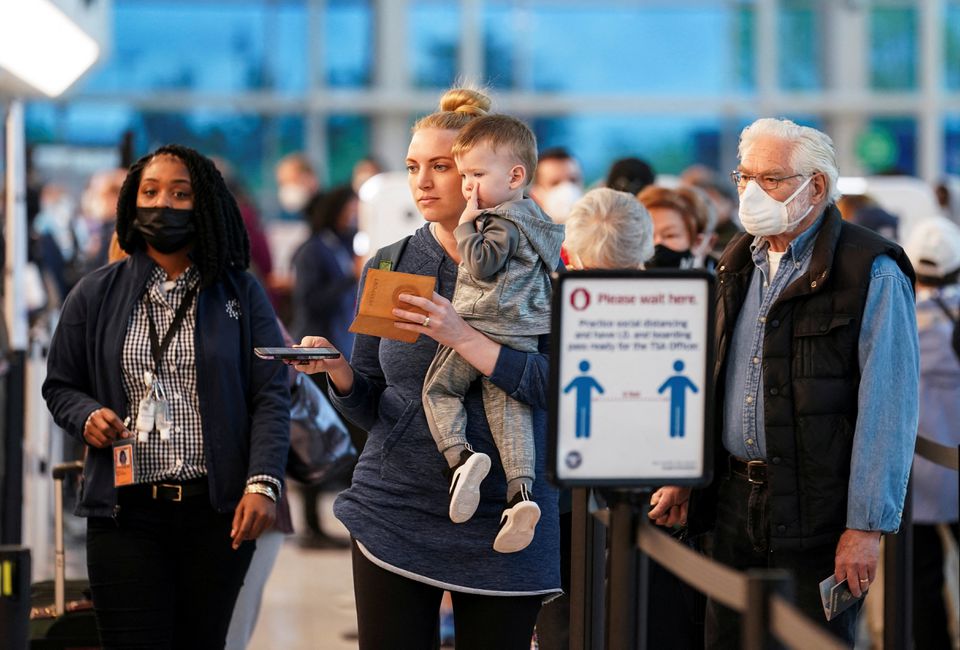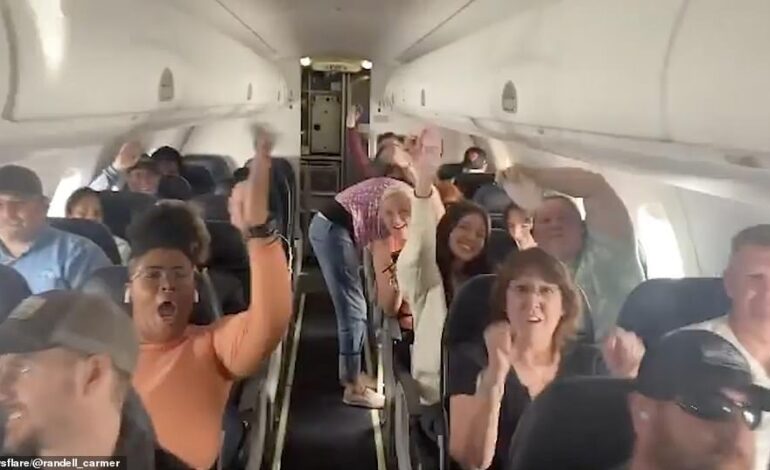With the mutations of Omicron now making up more than 90 percent of COVID-19 cases in the U.S., travelers in the country were suddenly informed that a court order had blocked the Biden administration’s mask mandate on public transportation this week.
That ruling from a federal judge on Monday came as COVID-19 infections are rising — particularly in Northeast states like New York, and Connecticut — with more than 400 people dying daily in the country, based on the latest seven-day average.
Overall cases have dropped sharply nationally since hitting record levels earlier this winter.
The BA.2.12.1 sub-variant is an offshoot of the BA.2 version of Omicron. Together, BA.2 and the BA.2.12.1 sub-variant dominate cases in the U.S, with BA.2 still making up a vast majority of the cases.
Omicron was already shown to be much more spreadable than past mutations of the coronavirus.
The new sub-variant is 23 to 27 percent more transmissible than BA.2, which itself was more transmissible than the original Omicron variant. But like the original Omicron, there’s currently no evidence to suggest that BA.2.12.1 causes more severe disease than previous mutations like Delta.
Increased vaccination and booster access among vulnerable populations, plus continued masking in high-congregation areas like public transport, continued to be a priority for health officials to keep numbers down.
The Biden administration said on Tuesday it would appeal the judge’s ruling ending the mask mandate on airplanes if the CDC deems it necessary to stop the spread of COVID-19.
The CDC for its part said that it would continue to study whether the mandates were still needed.

Masked and unmasked travelers line up at a security checkpoint after the Biden administration announced it would no longer enforce a U.S. coronavirus disease mask mandate on public transportation, following a federal judge’s ruling that the 14-month-old directive was unlawful, at Ronald Reagan Washington National Airport in Arlington, Virginia, April 19. Photo: Kevin Lamarque/Reuters
“Disappointing”
Mask mandates applied to planes, trains and other public transportation and, prior to Monday’s ruling, had been due to expire on May 3.
The ruling by U.S. District Judge Kathryn Kimball Mizelle, an appointee of former President Trump, came in a lawsuit filed last year in Tampa, Florida, by a group called the Health Freedom Defense Fund.
Mizelle ruled that the CDC had exceeded its authority with the mandate and did not either seek public comment or adequately explain its decisions.
The White House called the ruling “disappointing.”
A series of court rulings have recently challenged the administration’s mandates to fight the disease that has killed nearly 1 million Americans, including vaccine or test mandates for employers.
The CDC recommends that people continue to wear masks in indoor public transportation settings.
Major airlines like United Airlines, American and Delta all said masks are now optional on their planes. Other companies like Uber and Lyft also removed their mask requirements.
Vaccinations remain the top strategy
Earlier this month, health experts spoke to reporters at an Ethnic Media Services roundtable about what the BA.2 variant means for the future and possible strategies in the wake of new variants.
One such strategy is to build vaccines that specifically fight new variants.
“A lot of the concerns about vaccines have been that they don’t work against some of the other variants… It points us to a clear path forward, which is making more Omicron-like vaccines, which can be more effective,” said Dr. Ben Neuman, professor of biology and chief virologist of the Global Health Research Complex at Texas A&M University.
Neuman said the BA.2 and Omicron most likely came from a person who either couldn’t or didn’t have a vaccine. He said the immunity that people build to exposures or vaccines is temporary.
“The idea that children or anyone would have an immune system that’s strong enough to deal with COVID, but somehow so fragile that it’ll break under a vaccine has to be one of the weirdest things I have ever heard from a scientific perspective,” Neuman remarked.
The vaccinated ones are more protected, and the non vaccinated ones are the most vulnerable. — Dr. Dali Fan, UC Davis
Dr. Dali Fan, a health sciences clinical professor at UC Davis, said future protection from infections will rely on multiple factors involving vaccinations and spread.
“The vaccinated ones are more protected and the non vaccinated ones are the most vulnerable,” Fan said. “How far away from inoculation is the second factor: If your second dose or your booster dose is further away… And the third one is a general vulnerability: If the caseload in the community is higher, everybody’s vulnerability is higher.”
Dr. Manisha Newaskar, a pediatric pulmonologist at Stanford Children’s Health, said that though cases have waned from earlier this year, younger populations still require protections catered to their unique needs.
“There are other vulnerable populations: Children who are immunocompromised, who are undergoing cancer chemotherapy or have some other types of diseases, obesity or uncontrolled asthma, where they can’t mount an immune response… Over time, we have seen that these are the patients that have been hit the most,” Newaskar said.
Newaskar said kids who have experienced the pandemic understand that they may not be required wear a mask and are enjoying that time. “They also understand that there may be variants or new waves coming and this may change.”
Michigan currently stands at about 10,000 weekly cases. The latest seven-day average shows Wayne County to be at a low level for community spread, with some 95 people per 100,000 infected, and 4.7 per 100,000 new COVID-19 hospital admissions.






Leave a Reply